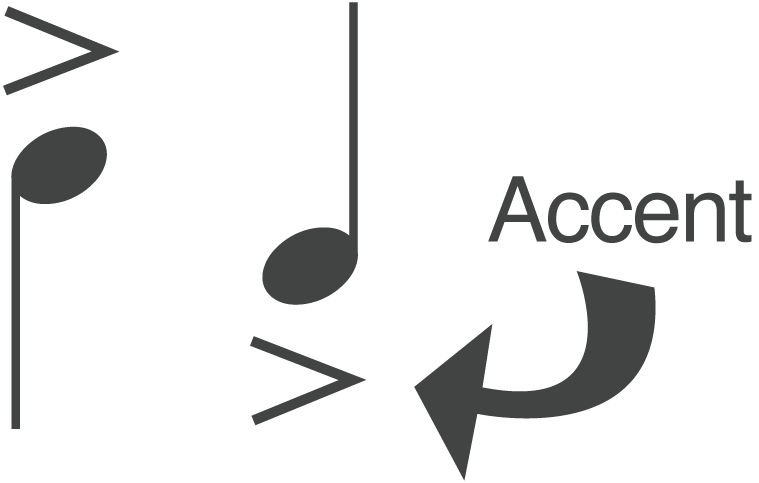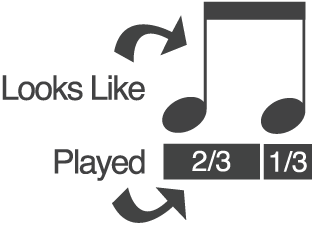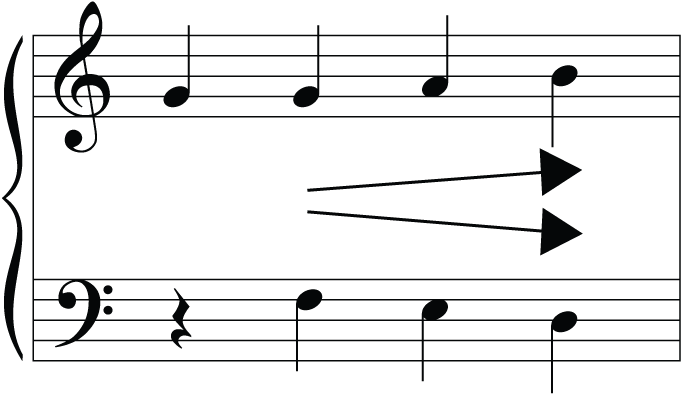Level 2
Level 2 is intended for students who have completed the Primer, Level 1A, and Level 1B piano lessons. Only one piece will be assigned each week. If you need a bigger challenge, add next week’s piece too. If you didn’t quite master your piece in one week, work on it for another week.
William Tell Overture is the first piece in your new piano book. The tempo (speed) of this piece is Allegro, which means fast. The secret of playing fast is practicing very slowly. Practice each two-measure phrase at a slow tempo. When you're ready, try it allegro.
Print your new piano book.
Meet the Teacher - J'ana DeLaTorre, Children's Theater Pianist and Piano Teacher
Alouette introduces the decrescendo (gradually softer) and reviews the crescendo (gradually louder).

Adding dynamics, like crescendo and decrescendo, make music more interesting to listen to.
It's important to master the notes and rhythms first, and then add these dynamics to enhance what you're already playing. You wouldn't put hot fudge in your bowl before the ice cream. Right? You add the ice cream first, and then add the hot fudge to make it even better.
Meet the Teacher - Andy Fling, Teacher of Award-Winning Students and Founder of MakingMusicFun.net
Ode to Joy is from Ludwig van Beethoven's "Ninth Symphony," which he wrote when he was completely deaf.
Let's learn about Beethoven with the Ode to Joy - Play and Learn™ Edition and the video lesson above. The Ode to Joy - Play and Learn™ Edition includes the Hey Kid's, Meet Ludwig van Beethoven biography, a word search worksheet, the Meet the Composer Job Application, and a coloring page. Complete all the worksheets this week. Next, ask a parent to quiz you so you can show them how much you learned.
Lavender's Blue reviews the ![]() time signature.
time signature.
Do you remember what the top and bottom numbers of a time signature mean?
If you don't remember, make a flash card for the top number and another one for the bottom number. Ask your parent to quiz you this week. Scroll to the bottom of this page for the answers.
Dixieland is an early jazz style that began in New Orleans and When the Saints Go Marching In, is one of the most popular Dixieland songs ever!
When the Saints Go Marching In has many challenging parts. Set a goal to master four measures each day. The best way to do that is to practice slowly and stay focused on your selected measures until you have played them correctly five times. By the end of the week you'll be playing this piece perfectly.
The accent is introduced in this lesson.

When this musical symbol is placed above or below a note, the note should be played a little louder. Placing extra emphasis on these notes adds variety and makes the music more fun to listen to. Check out the demonstration recording at the end of the lesson for an example of how to play the accented notes.
Chopsticks was written in 1877 by Euphemia Allen when she was only 16 years old. It was originally called, "The Celebrated Chop Waltz." The title was inspired by her instructions to play the melody and harmony part with both hands striking the keys in a chopping motion. The arrangement you'll learn this week is a little different than Miss Allen's original piece, but just as fun!
Record your performance after 3-4 days of practice to see if there are parts you can improve on.
Ask yourself:
Am I keeping a steady beat?
Am I playing the rhythms correctly?
Am I playing all the notes correctly?
Am I rounding my fingers?
Am I sitting up straight?
Work on the things that aren't perfect yet, and make another recording in a couple days to see if you improved.
Blue Bumblebee is your first piece with jazz rhythms. The eighth notes look the same, but they're played differently. The first note of every set of two eighth notes gets 2/3 of the beat and the second eighth note gets 1/3 of the beat.

It might take a few tries to get it right, but you can do it. After you've practiced Blue Bumblebee a few times, ask your parent to listen to you play. Next, ask them to compare your performance to the demonstration at the end of the lesson. They'll be able to offer ideas on how to make your performance even better.
Blue Bumblebee is a jazzy version of Nikolai Rimsky-Korsakov's Flight of the Bumblebee. Read the Hey Kids, Meet Rimsky-Korsakov composer biography to learn more about this famous composer, listen to a recording of Flight of the Bumblebee, and complete the following worksheets.
Alouette included the crescendo (gradually louder) and decrescendo (gradually softer) to add contrast to the music. The Galway Piper includes two contrasting sections. The first section (measures 1-8) should be played mf (mezzo forte) - which means medium loud. The second section (measures 9-16) should be played f (forte) - which means loud.

Practice The Galway Piper phrase by phrase and very slowly. When you can play this piece from beginning to end with a steady beat you'll be ready to add the dynamics.
The Galway Piper is a popular traditional Irish folk song that was published as early as 1740. It is also sometimes referred to as Celtic music because it originated in Ireland, Scotland, or Wales. The people who live there are known as Celts.
Turkish March was written by Ludwig van Beethoven. What do you remember about him from the Ode to Joy - Play and Learn™ Edition that you completed in Week 3?
Where was Beethoven born?
Which musical instruments did he play?
What were his most popular pieces?
The B-I-B-L-E is a worship song for kids. It reinforces the musical terms Andante and Contrary Motion.
Andante is a tempo term that means, walking speed. Can you remember other tempo terms from the pieces you have learned? Scroll to the bottom of this page for the answer.
Contrary means opposite. Contrary Motion means two parts moving in the opposite direction. In The B-I-B-L-E the right hand part is moving higher in measure 7 while the left hand is moving lower.

The Banana Boat Song (Day-O) is a Jamaican work song made popular by Harry Belafonte. Check out a YouTube video of this song before you get started.
To make this piece sound great, you'll need to make sure the staccato notes are played correctly and the phrases are played at the right dynamic level - mf or f.
Staccato - An Italian term that means play the note short.Mezzo Forte (mf) - An Italian term that means medium loud.
Forte (f) - An Italian term that means loud.
Boom, Boom, Indian Drum gives you an opportunity to practice adding dynamic contrast to your music. The A section are mezzo forte (mf) which means medium loud, and the B section is forte (f) which means loud. After you have this piece sounding great, try adding dynamics.
Ready for some "secret agent" fun? Grab the Codebreaker worksheet on page 12 of your piano lesson book. Correctly identify each note and write its corresponding letter name on the blank below. The code is broken when the letters reveal a secret word.
The can-can is a high-energy dance that was popular in music halls in the 1840s. Today the can-can is traditionally performed by a chorus line of female dancers in skirts and petticoats. Their dance includes high kicks, splits, and cartwheels.
Playing with a steady beat is always your most important goal. After you've had a few days to practice Can-Can, try playing it with a metronome. There are many free metronomes that you can download to your tablet or mobile phone. Begin by practicing Can-Can at 60 beats per minute (BPM). When you can play Can-Can perfectly at this tempo, try it at the tempo performed in the demonstration at the end of the lesson.
Irish Washerwoman gives you another chance to practice playing music with a ![]() time signature.
time signature.
Most players and dancers like to perform Irish Washerwoman at a pretty fast tempo. Learn this piece at a very slow tempo first. Next, check out YouTube recordings to see how fast other people like to play this tune. Try to match their tempo with a mistake free performance of your own.
Hickory Dickory Dock is a partner piece to Irish Washerwoman. Practicing both pieces back to back will provide you with plenty of time to get used to playing in the key of F Major.
Are you remembering to play with a steady beat? It's far more important than playing all the right notes.
Zum Gali Gali is in a minor key, which gives the piece a dark sound. Most of your pieces so far have been in a major key, which gives the piece a bright sound.
Zum Gali Gali includes a ritardando at the end of the piece. Ritardando is often abbreviated rit. When you see this marking you should gradually slow down. Listen to the demonstration several times until you're able to imitate your teacher.
Aiken Drum is a Scottish kids song with hilarious lyrics. After you learn the song, check out the lyrics and sing along.
Aiken Drum is believed to be a mythical character called a "Brownie." A brownie is an elf or fairy found in Scottish and Northern English folklore. In Scotland, the most well-known brownie is mentioned in the poem, "The Brounie o Blednoch" by William Nicholson. His name is Aiken Drum.
Lyrics for "Aiken Drum"
There was a man lived in the moon,
Lived in the moon, lived in the moon
There was a man lived in the moon,
And his name was Aiken Drum.
And he played upon a ladle, a ladle, a ladle
And he played upon a ladle,
And his name was Aiken Drum.
Get more lyrics...
Dance was written by Russian composer and teacher, Dmitri Kabalevsky (1904-1987). As a young boy, Dmitri was encouraged by his father, a mathematician, to study mathematics. His interests, however, drew him to the arts. Eventually, he became an accomplished pianist with interests in poetry and painting. He even spent three years as a theater pianist playing for silent films.
Kabalevsky's most important contribution to music was his consistent effort to connect kids to music. His "Twenty-Four Little Pieces" for piano solo is an example of the music he composed with the intention of helping kids grow as musicians and develop their own appreciation for music. Dance is from that collection of pieces.
Git Along Little Dogies is a cowboy song. "Dogies" referred to the young cattle that were strong enough to be herded from Texas to Wyoming.
Let's drill your note names this week. Get your flash cards out and select 10 notes that you don't know very well. Ask a parent to help you drill them each day.
The tune for My Ma Gave Me A Nickel began as music from the Spanish operetta "Los Inocentes" (1895). Sometime after that the original tune was adapted and new lyrics added. In the 1950s movie star and singer, Dean Martin, popularized My Ma Gave Me A Nickel with his recording.
My Ma Gave Me A Nickel reviews the accent.

When this musical symbol is placed above or below a note, the note should be played a little louder. Placing a little extra emphasis on these notes adds variety and makes the music more fun to listen to.
Prince of Denmark March, also called the Trumpet Voluntary, was written around 1700 by the English composer Jeremiah Clarke. It is one of the most popular choices for wedding music and is often performed by solo trumpet and pipe organ.
Prince of Denmark March should be played in a "majestic" style. To play music in this style, it's important to perform with a steady beat and confident sound. After you learn the notes, use the demonstration recording at the end of the lesson to better understand the style.
"Spring" by Italian Composer Antonio Vivaldi is a composition from a larger work called, Four Seasons. It's a collection of four violin concerti for each season of the year. They were written around 1716–1717 and published in Amsterdam in 1725. They are the best known of Vivaldi's works.
This arrangement of "Spring" is your longest piece yet. It's not any more challenging than other pieces that you have been learning - just longer. Don't worry about finishing it in one week. Take two or three weeks to make it perfect, make a video recording, and post it to YouTube. You'll enjoy checking it out in the future.
Take a few minutes this week to learn even more about Antonio Vivaldi. Print the Meet Vivaldi | Video Lesson Study Guide and then watch the Meet Vivaldi | Popsicle Stick Theater Production video lesson.
This week you'll learn to play "We Don't Talk About Bruno" from Disney's Encanto. It's a longer song than many of the pieces you've learned, but it's not harder. It may take 2 or 3 weeks to master this arrangement.
The melody for "We Don't Talk About Bruno" is very syncopated. The musical term syncopation refers to the notes that are played between the taps of your foot. The goal of syncopation is to emphasize notes that are not typically emphasized to give the music a different groove.
This lesson is created through a collaboration with MusicNotes.com, the leading digital sheet music publisher.
"Silent Night" was first performed in Nicola-Kirche (Church of St. Nicholas) in Oberndorf, Austria. Father Josef Mohr wrote the words to this carol in 1816. In 1818, Father Mohr asked headmaster Franz Gruber to compose a melody to his text and perform it on the guitar for their Christmas service. From that humble beginning, "Silent Night" has become one of the most popular carols of all-time and has been translated into over 300 languages and dialects throughout the world.
This arrangement of "Silent Night" provides you with another opportunity to practice the dotted quarter note - eighth note rhythm.
 Count the dotted quarter note - eighth note rhythm out loud as your teacher recommends and you'll be playing this rhythm perfectly every time.
Count the dotted quarter note - eighth note rhythm out loud as your teacher recommends and you'll be playing this rhythm perfectly every time.
Congratulations! This week you'll complete the MMF All-in-One Piano Lesson Book, Level 2 and be ready to start Level 3 next week.
Print a music award certificate when you can successfully perform "Silent Night" for your parent with a steady beat and no mistakes.
Answer: Week 4
Top Number - The top number of a time signature tells you how many beats per measure.
Bottom Number - The bottom number of a time signature tells you which rhythmic duration (half note, quarter note, eighth note) gets the beat - or the tap of your foot.
Answer: Week 10
Allegro - Fast
Moderato - Moderate or Medium
